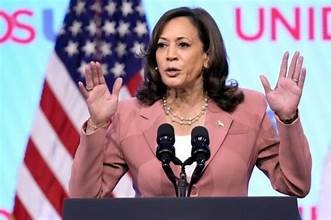As the 2024 U.S. election cycle concludes, many political analysts are asking: What went wrong for Kamala Harris? Once seen as a rising star in the Democratic Party, Harris faced numerous obstacles on her path to the White House. From political headwinds to evolving voter preferences, let’s examine the key factors that influenced the outcome of her campaign and assess where the roadblocks appeared for Harris.

Kamala Harris’ Role as Vice President
Since taking office in January 2021, Kamala Harris has had the challenging role of serving as both Vice President and a prominent figure within the Biden administration. Traditionally, vice presidents often maintain a supportive role, navigating the fine line between loyalty to the president and establishing their own political identity. Harris’s tenure has been marked by her dedication to pressing issues like immigration reform, voting rights, and women’s health. However, her portfolio placed her in politically challenging roles that brought both praise and criticism.
Expectations from the 2024 Campaign
Rising Star in the Democratic Party
When she was selected as Biden’s running mate in 2020, Kamala Harris was celebrated as the first Black and South Asian woman on a major party’s ticket. This historic milestone catapulted her to the center of U.S. politics, and expectations were high. Many Democrats saw Harris as a potential successor to Biden, with hopes that she would secure the support of a diverse coalition of voters.
Initial Strengths and Strategic Goals
Harris’s experience as a former U.S. senator and attorney general gave her a robust background in law and policy. Her early focus areas, including criminal justice reform and economic opportunity, resonated with certain Democratic voters. The 2024 campaign aimed to leverage her legal expertise, progressive policies, and diverse background to energize the Democratic base and appeal to undecided voters.
Key Factors that Affected Harris’ Campaign
Policy Challenges
Harris faced significant challenges in addressing hot-button issues like immigration and voting rights. Her assignment to lead the response to the border crisis exposed her to scrutiny, as her efforts to tackle migration from Central America didn’t yield quick, visible results. Additionally, the inability to pass substantial voting rights legislation dampened her appeal to some of her core supporters.
Public Perception and Media Coverage
Harris’s public image was also impacted by persistent criticism from conservative media and lukewarm support from some progressives. While her supporters saw her as a capable leader, detractors painted her as out of touch, and media coverage often highlighted perceived gaffes or missteps. This portrayal may have influenced public opinion, making it harder for her to connect with a broader audience.
Impact of Biden Administration’s Record
Economic Issues and Inflation
Economic concerns, particularly rising inflation, became a dominant issue during the Biden administration. As vice president, Harris bore some of the political weight for these issues, despite limited influence over economic policy. Public frustration over the cost of living impacted voter confidence, and Harris’s association with these issues affected her campaign.
Foreign Policy Setbacks
The Biden administration faced various foreign policy challenges, from the chaotic Afghanistan withdrawal to diplomatic tensions with China and Russia. As part of the administration, Harris’s credibility was indirectly tied to these events, which may have contributed to voter skepticism about her leadership on global issues.
Challenges in Voter Support
Decline in African American Voter Enthusiasm
African American voters are a critical demographic for the Democratic Party. While Harris’s candidacy initially garnered enthusiasm, waning support became evident as certain policy initiatives stalled. This demographic is essential for any Democratic win, and a lack of substantial engagement efforts may have reduced Harris’s appeal among these voters.
Disengagement Among Young Voters
Young voters, typically more progressive, showed signs of disillusionment with the pace of policy change under the Biden-Harris administration. Progressive causes, including climate change and student debt relief, did not advance as many young voters had hoped, potentially affecting Harris’s support among younger demographics.
Republican Strategy and Its Impact
The Republican Party’s strategy played a substantial role in countering Harris’s appeal. The GOP emphasized the shortcomings of the Biden administration, focusing on economic and border issues. Additionally, Republican leaders effectively painted Harris as an establishment figure disconnected from the daily struggles of Americans, which may have resonated with undecided voters.
Internal Democratic Party Divisions

Progressive vs. Moderate Tensions
Tensions within the Democratic Party between its progressive and moderate factions created obstacles for Harris. Progressives advocated for bold changes on healthcare, climate policy, and economic reforms, while moderates favored incremental policies. Harris’s attempt to appeal to both groups ultimately left some feeling unrepresented, complicating her campaign efforts.
Harris’ Image in the Media
Negative Portrayal and Public Opinion
Harris’s image in the media has often been polarized. Right-leaning outlets frequently criticized her approach and attributed administrative setbacks to her influence, while some liberal commentators suggested she hadn’t fulfilled her potential as a change-maker. These varying portrayals may have impacted public opinion and voter confidence in her ability to lead.
Comparisons with Past Vice Presidents
Harris faced additional scrutiny due to comparisons with past vice presidents. Figures like Mike Pence and Joe Biden often retained distinct political identities that helped solidify public trust. Harris’s role, in contrast, seemed more challenging to define, as her involvement in high-profile issues both boosted her profile and opened her up to more criticism.
Missed Opportunities in Campaign Strategy
Some analysts argue that Harris’s campaign strategy missed key opportunities. While she focused on core Democratic issues, her message may not have reached undecided or moderate voters effectively. Missed chances to connect with suburban voters, small business owners, and middle-class families may have weakened her broader appeal.
Harris’ Debate and Public Speaking Moments
Throughout the campaign, Harris’s public speaking engagements were scrutinized. In debates and interviews, her approach was sometimes criticized as overly rehearsed, which detractors claimed came across as inauthentic. Despite her legal background and oratory skills, this criticism may have contributed to a perception of being unapproachable or distant.
Polling Data Analysis
Polling data leading up to the election showed fluctuating levels of support for Harris. Initial enthusiasm gradually declined, with polls indicating concerns about economic policy, immigration, and healthcare as central issues for voters. Polling also reflected Harris’s challenges in gaining the trust of swing voters, who were swayed by broader economic concerns and media narratives.
Conclusion
Kamala Harris’s campaign faced an array of challenges, from internal party dynamics to a critical media landscape. While she was poised to make history and inspire a diverse voter base, numerous factors—including economic concerns, divisive media coverage, and strategic missteps—played a role in shaping the outcome of her 2024 campaign. As the Democratic Party reflects on this election cycle, Harris’s experience may offer valuable insights into the evolving demands of American voters.
FAQs
Q1: Why did Kamala Harris struggle to gain voter support?
A1: Harris faced challenges due to economic issues, policy setbacks, and media portrayals. Internal Democratic Party divisions also complicated her campaign strategy.
Q2: What role did the media play in Kamala Harris’s campaign?
A2: Media coverage often highlighted her challenges and sometimes portrayed her negatively, influencing public perception and voter trust.
Q3: How did the Biden administration’s record impact Harris’s campaign?
A3: Economic concerns, such as inflation, and foreign policy challenges affected Harris’s image, as she was closely associated with the administration.
Q4: Why was support among young voters lacking for Harris?
A4: Young voters were disillusioned by the slow pace of change on progressive issues like climate policy and student debt relief, reducing enthusiasm.
Q5: What could the Democratic Party learn from Kamala Harris’s campaign?
A5: The party could consider clearer messaging, address economic concerns more directly, and focus on engaging a broader range of voter demographics.

